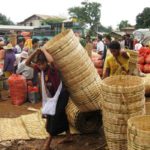 You recognize the picture, right? Or something like it?
You recognize the picture, right? Or something like it?
The jungle creeps across the ruins, engulfing them in serpentine tree roots. There is a sense of slow-motion menace here, of inevitable decay.
It’s beautiful.
Even the entrance to the temple compound promises decay and grandeur on a romantic scale.
Construction of Ta Prohm, originally named Raja Vihara, was begun in 1186 AD and lasted for forty years. After the fall of the Khmer Empire in the fifteenth century, the temple was abandoned and fell into jungle-engulfed ruins.
But the romance of Ta Prohm is now somewhat disappearing. The place is being fixed up and made safer for its two or three million annual tourist visitors. It is a monument worth protecting, both from the trees and from the tourists, but I do hope that the moody atmosphere is not destroyed in the process.
Meanwhile, the army of trees continues its quiet, merciless invasion.






























































































